

 ASO in Japan official website
ASO in Japan official website
Nestled in the heart of Aso lies its magnificent grasslands, a testament to the enduring harmony between nature and human stewardship. Chronicled in Japan’s oldest historical record, the Nihon Shoki, written over 1300 years ago, the Aso grasslands are fondly referred to as the “Thousand-Year Grasslands”. In stark contrast to the grasslands typically found in arid, cool environments, the Aso grasslands thrive under Japan’s distinct four seasons and abundant rainfall. In such a climate, unchecked vegetation quickly transforms into dense woodland. Without human intervention, the Aso Grasslands as we know them would cease to exist. Unlike the African savannas or the high mountain meadows, Aso’s grasslands owe their persistence to the delicate balance and the collaborative care of people and nature. They stand as a living symbol of a nurtured coexistence, a unique landscape meticulously crafted and maintained through centuries.
Nature that flourishes under human care is a reality. Untouched nature holds a romantic and pristine beauty. Yet, just as unattended forests can exacerbate the impact of natural disasters, there are environments where a delicate human touch is essential for maintaining balance. The key lies in the delicate act of humans contributing just enough to complement nature’s needs. In the Aso grasslands, this symbiotic relationship between humans and nature yields bountiful gifts, visible and tangible to those who visit.
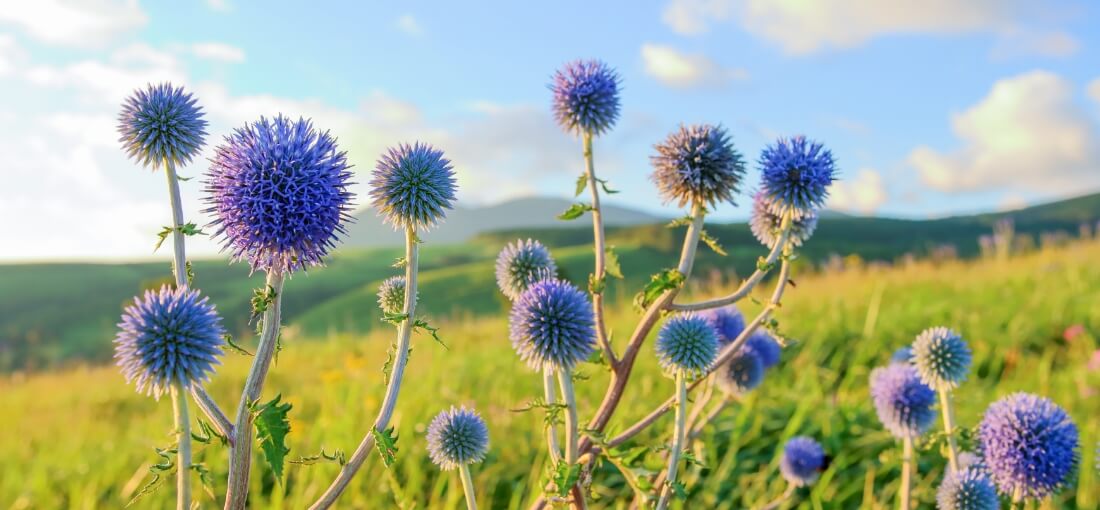
The grasslands of Aso are a sanctuary for biodiversity, home to approximately 600 species of rare plants and insects, including endangered species like the “Hinahigotai” or Snow Lotus (Saussurea japonica) and “Ogurasennou” (Lychnis kiusiana) These diverse plant species form the foundation of a complex food web, supporting various insects, herbivores, and carnivores. Remarkably, of the 117 species of butterflies found in Kumamoto Prefecture, 109 inhabit the Aso grasslands, earning it the nickname “Butterfly Paradise.”
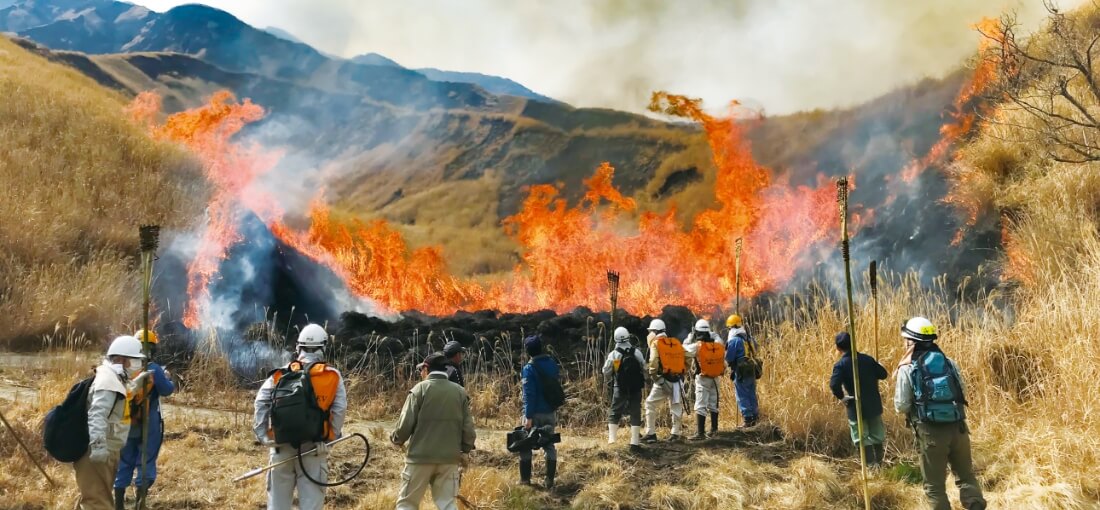
Research into the soil strata beneath the grasslands has revealed that in Aso, controlled burning has been practiced for about 10,000 years. This ancient ritual has led to the accumulation of immense amounts of carbon in the soil of Aso’s grasslands. Remarkably, these grasslands absorb 1.7 times more carbon annually than the total carbon dioxide emitted by all households in the Aso area, contributing to the global effort to prevent climate change.

The grasslands have a unique ability to store rainwater in the soil and slowly release it to rivers. They effectively manage water during heavy rains, preventing rapid discharge, and continue to provide moisture even in dry periods. Recent research shows that grasslands are more effective at this than forests. With an annual rainfall of about 3,000 mm, double Japan’s national average, the rain absorbed by the mountains surrounding the Aso Caldera and the Five Peaks of Aso feeds into six major rivers. These rivers are vital for the water supply of nearly 5 million people in the area, earning the region its reputation as Kyushu’s water reservoir.
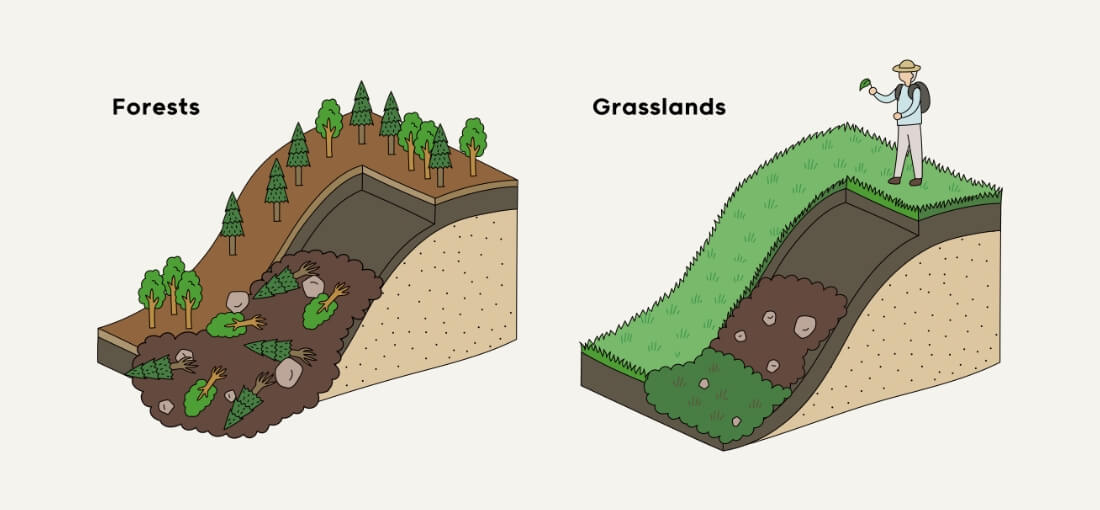
Much of the Aso region is composed of soil formed from volcanic ash, making it prone to landslides during heavy rains. The presence of hard volcanic bedrock beneath the volcanic ash soil leads to shallower tree root systems, which can result in forest areas being unable to prevent landslides. In areas of afforestation, landslides can be more severe as both soil and trees collapse together, increasing the extent of damage. However, in grassland areas, the impact of such disasters is typically less severe.
In Aso, each year in March, the practice of controlled burning, known as “Noyaki,” is undertaken. The locals set fire to the grasslands to burn off the remaining dead grass. If left unattended, the grasslands would turn into forests. Controlled burning is crucial to prevent this transformation. It’s also effective in eliminating ticks that harm livestock. After the burning, new sprouts of grass and flowers quickly emerge from the scorched earth, transforming the landscape back to green. The people of Aso, risking their lives in this practice, consider controlled burning an indispensable part of maintaining the grasslands.
Recent research has revealed that the soil of Aso’s grasslands contains an extraordinarily large amount of carbon, unparalleled worldwide. This carbon accumulation is attributed to decomposed materials like roots of wild grasses and the fine charcoal left after burning (mainly from the above-ground parts of grass-family plants), which has been accumulating over a long period.
It’s estimated that the CO₂ absorption of grasslands where controlled burning is practiced is about 6.9 tons per hectare per year. When considered across the entire grassland area, this equates to the grasslands sequestering 1.7 times the amount of carbon dioxide emitted annually by all households in Aso. Comparing the greenhouse gasses emitted from controlled burning (such as carbon dioxide and methane) with the CO₂ absorption reveals that the absorption effect is greater.
Thus, it’s becoming clear that the maintenance of grasslands through controlled burning could significantly contribute to combating global warming, a critical issue on a global scale.
Grazing cattle is another traditional method used to preserve the grasslands of Aso. Allowing cattle to graze on the mature grass helps promote the growth of new grass.
Cattle, with their strong legs capable of navigating steep valleys and areas inaccessible to humans and machinery, freely roam the grasslands while grazing. With over 70% of the grasslands unreachable by tractor, maintaining these areas through cattle grazing is a natural process. The cattle are indispensable in protecting the unique flora of Aso’s grasslands.
In autumn, grass harvesting takes place in the grasslands of Aso. The cut grass is used as fodder for cattle and horses, and as bedding in cowsheds. Dry winter grass is also harvested for re-thatching cultural heritage buildings with thatched roofs, providing income for locals. Furthermore, unused dried grass, when mixed with soil, becomes high-quality compost, serving as green manure for farming and nurturing delicious crops. By harvesting grass, new grasses and flowers sprout, and the harvested grass itself becomes a valuable resource.
In the 1950s-70s, modernization-driven development led to the reduction of wild grass areas. In the last century, Aso’s grasslands have shrunk to less than half, with a near 25% decrease in the last 30 years, totaling around 7,500 hectares.
Formerly, these grasslands were vital for building homes, feeding livestock, and creating compost for farming. But as agricultural methods and lifestyles evolved, with more mechanical farming and chemical fertilizers, and fewer thatched roofs, the reliance on grasslands dwindled. Additionally, the dwindling and aging population has led to a lack of young people to continue the practice of controlled burning, putting the future of Aso’s grasslands in peril.
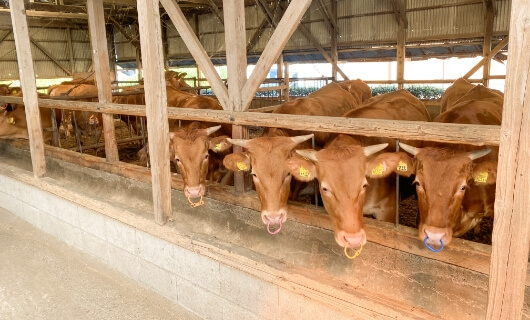
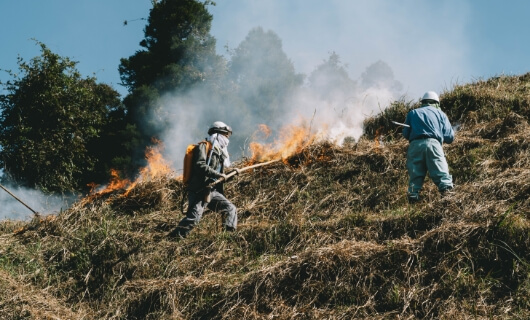
There are numerous ways to support the grasslands. Beyond volunteering and fundraising, simply visiting Aso, enjoying its landscapes, and learning about the grasslands are the first steps in making a connection. Engagement with the grasslands is a path to securing their future.
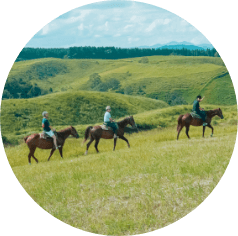
Taking an interest in and learning about the grasslands, as well as enjoying tourism and activities, contribute to their preservation. While traditionally the focus has been on simply enjoying the beautiful scenery, recent years have seen an increase in activities that allow access into normally restricted areas of the grasslands, with permission from the pasture associations and accompanied by a guide.
A portion of the tour fees goes towards the maintenance of the grasslands. Activities like guided trekking, horseback riding, mountain biking, yoga, and BBQs offer everyone a chance to engage with the charm of the grasslands and contribute easily to their restoration through these experiences.
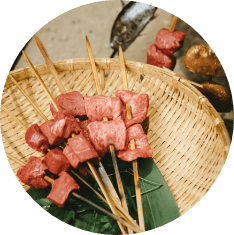
In Aso, the grasslands are home to the “Akaushi” (Japanese brown) cattle, raised through traditional grazing methods. This grazing not only nourishes the cattle but also plays a vital role in maintaining the pristine grasslands, as their movement helps to compact the soil.
The number of Akaushi cattle farms has been declining over the years. However, by consuming Akaushi beef, we can increase its demand. This rise in demand can encourage more farming of Akaushi, leading to an increase in their numbers and, consequently, contributing to the protection of the grasslands. It is estimated that eating 100g of Akaushi beef helps maintain about 7.5 square meters of grassland.
When participating in activities or entering the grasslands, it’s important to follow your guide’s instructions and adhere to the established rules. This approach is essential to protect the grasslands and create an environment that can be sustainably used and enjoyed.

To prevent diseases such as foot-and-mouth, perform disinfection with lime powder before entering. Always follow the guide’s instructions.

Entry to the grasslands requires permission. Do not enter any grassland areas without it.

Do not take or remove any plants or animals from the grasslands. Feeding wildlife is also not allowed.

Do not leave any rubbish behind. Always take it with you, and if you find any litter within or around the grasslands, please pick it up.

Using fire is strictly prohibited except by activity guides. This rule is crucial to prevent wildfires in the grasslands.
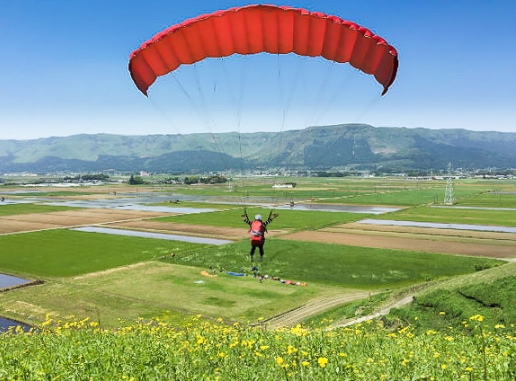
The experience of piloting a paraglider for two allows you to get a bird's eye view that you would never see if you were living your daily life. This is a true aerial experience, and the only way to experience the incredible scenery and voices of the sky in the majestic Aso region!
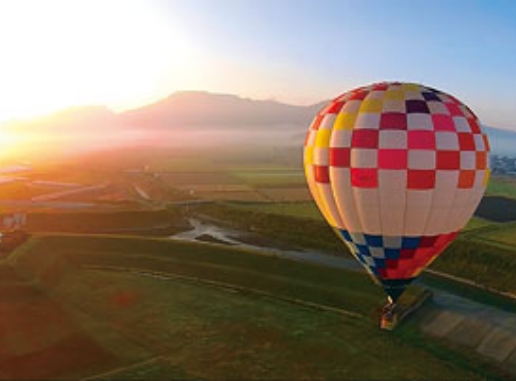
Moored with a rope, the hot air balloon rises to a maximum height of about 40 meters. Looking down at the magnificent scenery is an exhilarating experience! If you want to try the operation to build a fire on the burner, ask the pilot! Burning the burner, "Gosh! and feel the power of the explosion. It's an experience you won't find often!
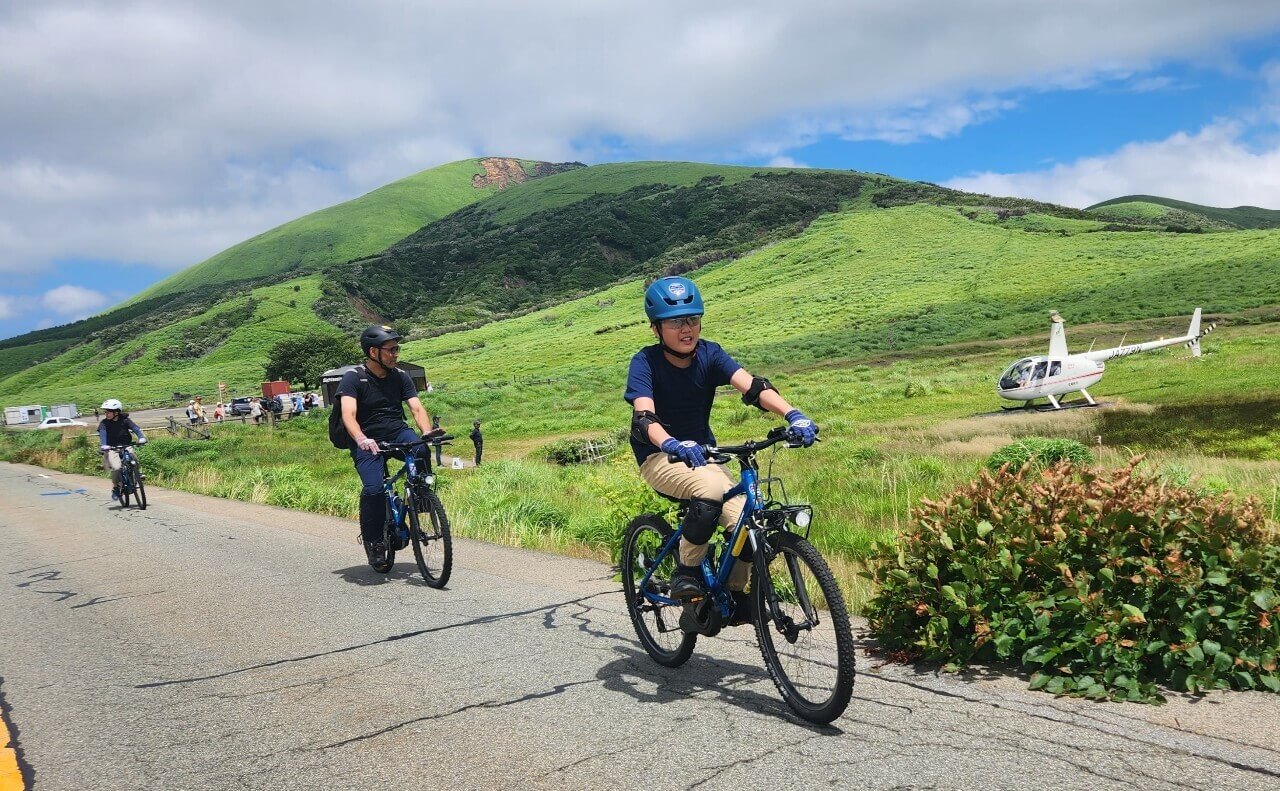
Ride an e-bike to the Nakadake crater. You can enjoy riding on the grasslands while feeling the heartbeat of Aso, a living volcano that continues to emit volcanic smoke! The electric assist makes it easy to ride up steep hills that are too steep for ordinary bicycles! You can look into the bottom of Mt. Aso Nakadake crater and enjoy a fun and thrilling ride in the grassland.
Accessible by car or local bus, this tour is popular with families, couples, and small groups. Foreign visitors are also welcome! You can feel the volcanoes, grasslands, and history of Aso with your whole body!
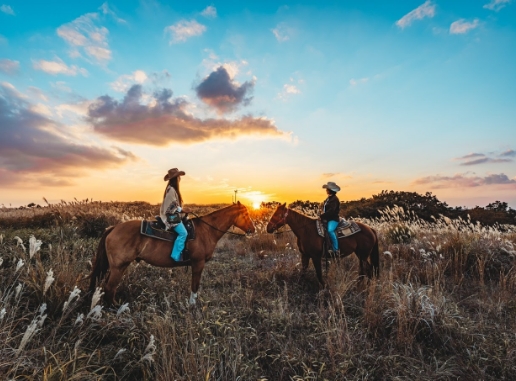
Experience the vast 360-degree panoramic grassland and the varied outings through mountains and valleys!
Green Valley is located on the northern outer rim of the 850-meter-high mountain range, overlooking Mount Aso and the Kuju Mountain Range.
In outriding, participants go out to grasslands and other places on horseback.
Enjoy the great outdoors while walking or galloping.
Green Valley's therapy horses are safe even for beginners.